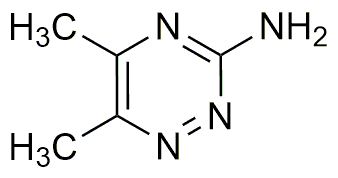3-Amino-5,6-dimethyl-1,2,4-triazine is widely utilized in research focused on:
- Agricultural Chemicals: This compound serves as an effective intermediate in the synthesis of herbicides and pesticides, helping to enhance crop protection and yield.
- Pharmaceutical Development: It is explored for its potential in developing new pharmaceuticals, particularly in the area of anti-cancer agents, due to its unique triazine structure that can interact with biological targets.
- Polymer Chemistry: Used in the formulation of specialty polymers, it contributes to improved thermal stability and mechanical properties, making it valuable in the production of high-performance materials.
- Analytical Chemistry: This compound is employed as a reagent in various analytical techniques, facilitating the detection and quantification of other substances in complex mixtures.
- Food Industry: It can be utilized in food chemistry for the development of food additives, enhancing flavor profiles or preserving food quality without compromising safety.
General Information
Properties
Safety and Regulations
Applications
3-Amino-5,6-dimethyl-1,2,4-triazine is widely utilized in research focused on:
- Agricultural Chemicals: This compound serves as an effective intermediate in the synthesis of herbicides and pesticides, helping to enhance crop protection and yield.
- Pharmaceutical Development: It is explored for its potential in developing new pharmaceuticals, particularly in the area of anti-cancer agents, due to its unique triazine structure that can interact with biological targets.
- Polymer Chemistry: Used in the formulation of specialty polymers, it contributes to improved thermal stability and mechanical properties, making it valuable in the production of high-performance materials.
- Analytical Chemistry: This compound is employed as a reagent in various analytical techniques, facilitating the detection and quantification of other substances in complex mixtures.
- Food Industry: It can be utilized in food chemistry for the development of food additives, enhancing flavor profiles or preserving food quality without compromising safety.
Documents
Safety Data Sheets (SDS)
The SDS provides comprehensive safety information on handling, storage, and disposal of the product.
Product Specification (PS)
The PS provides a comprehensive breakdown of the product’s properties, including chemical composition, physical state, purity, and storage requirements. It also details acceptable quality ranges and the product's intended applications.
Certificates of Analysis (COA)
Search for Certificates of Analysis (COA) by entering the products Lot Number. Lot and Batch Numbers can be found on a product’s label following the words ‘Lot’ or ‘Batch’.
*Catalog Number
*Lot Number
Certificates Of Origin (COO)
This COO confirms the country where the product was manufactured, and also details the materials and components used in it and whether it is derived from natural, synthetic, or other specific sources. This certificate may be required for customs, trade, and regulatory compliance.
*Catalog Number
*Lot Number
Safety Data Sheets (SDS)
The SDS provides comprehensive safety information on handling, storage, and disposal of the product.
DownloadProduct Specification (PS)
The PS provides a comprehensive breakdown of the product’s properties, including chemical composition, physical state, purity, and storage requirements. It also details acceptable quality ranges and the product's intended applications.
DownloadCertificates of Analysis (COA)
Search for Certificates of Analysis (COA) by entering the products Lot Number. Lot and Batch Numbers can be found on a product’s label following the words ‘Lot’ or ‘Batch’.
*Catalog Number
*Lot Number
Certificates Of Origin (COO)
This COO confirms the country where the product was manufactured, and also details the materials and components used in it and whether it is derived from natural, synthetic, or other specific sources. This certificate may be required for customs, trade, and regulatory compliance.


